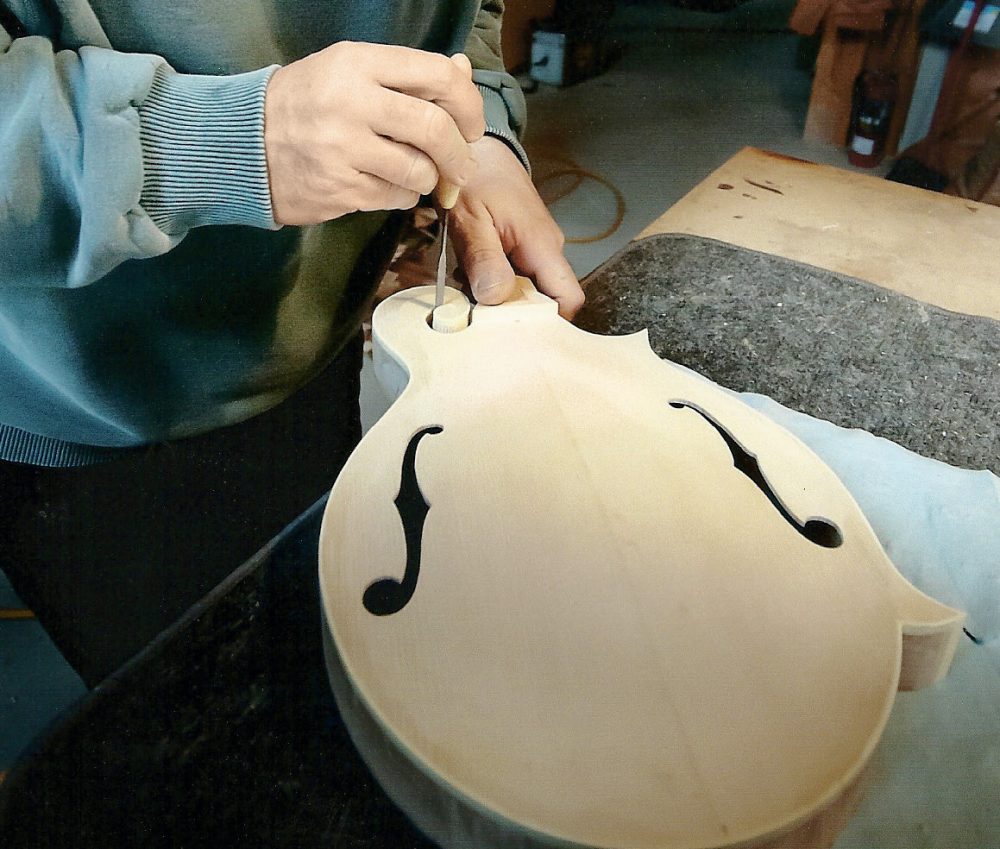In the words of luthier Michael Heiden, “bluegrass music is a very tight, sparse ship” where the mandolins “sit in the middle, giving bluegrass that loping feel that can be throaty.” Indeed, maestro mandolinists such as John Reischman, Emory Lester, Ben Winship, Ry Cooder, and Andrew Collins will bend the notes from Heiden’s mostly maple-backed instruments whose tops of the softest spruce relay a quiet, sweet sound.
Bluegrass mandolins generally need to look a certain way, based on the Gibson mandolins from the 1920s, and Heiden started making them 21 years ago. After 30 years of being on the road with bands, he decided to “stay in one play and watch my tomatoes grow.” He and his wife, Kay, spent 16 years in Chilliwack, and four years ago, they decamped to the western slopes of the Creston Valley, where their vegetable garden burgeons with produce. A rafter of wild turkey leap up and down outside its perimeter, poaching Heiden’s table grapes, while in his luminous workshop, redolent with the smell of fine woods and that distinct sound of steel strings, he creates the gorgeous instruments for which he is renowned.
Musical apprenticeships start early, and Heiden’s was no exception. He began playing guitar at age nine, and upon graduation from Lord Byng Secondary School, floated across with the era to Galiano Island to inhabit a plastic dome from which he would emerge to watch a seventies commune of musical instrument makers build harps and dulcimers. He too built a few dulcimers, and eventually his first guitar at the mere age of 22.
“The best luthiers are often players,” says Heiden, who joined the hippie circuit, becoming an alumnus of the Kitsilano Kat Kickers, “eating, sleeping, and breathing Stéphane Grappelli and the great Django Reinhardt” in the days when they opened the Second Annual Vancouver Folk Music Festival. “For the good gigs, like City Hall, we changed our band name to Mystery Pacific, after that great Django tune,” says Heiden, his eyes crinkling as he recalls those times, his old dog Cappie (short for Cappucino) stretched out in the sun at his feet.
Over the years, Heiden has made 200 mandolins; what distinguishes his work is his set-up. “On the neck, the relationship of the strings to the fingerboard and bridge is crucial for correct action. You don’t want rattles,” he says, “and everyone plays differently.”
His computerized numerical control machine has been indispensable for the past 15 years when he became one of the first independent luthiers to go this route. “No more brutalizing of the wood to get it into this shape,” he says, stroking a maple backing, before he employs finger planes to do the final gradients and Titebond glue, which dries crystal hard to adhere the parts. Evo gold fret wire completes the assemblage.
Such fine craftwork is not without its hazards. “I used to finish with lacquer but the smell is toxic and made me feel ill in the spray booth, so since 1999 I went to varnish, three or four coats, cured in ultraviolet, finished with a French polish topcoat which is organic and sexy.” Varnish dries chemically, whereas molecules are held in tension on the tense surface of lacquer, so they evaporate as they dry, giving off those gases.
Chemistry aside, luthiers are also a brotherhood. A recent visitor to the Creston homestead has been Vancouver luthier Michael Dunn. He too played in the Kitsilano Kat Kickers with Heiden, and luthier bros are always branching out, always learning. Dunn apprenticed in Spain 47 years ago as a classical guitar maker, at a time when the glue was still made from boiled-down horses hooves. On a trip to Gambia, West Africa, Dunn learned how to make a 21-string kora bridge-harp, then came home to build for his wife an Ojibwe rice-harvesting canoe. Luthiers know, love, and share their knowledge of woods: Brazilian rosewood, ebony, bloodwood, snakewood, beech, satinwood, and Honduras rosewoods make up a recent Dunn cubist guitar.
At the end of the musical day, says Heiden, it’s finally all about the sound and the deep friendships formed with his clientele. Sitting on his deck, he sketches in the air a world-web of musicians who use his mandolins to bend that sound, while his tomatoes grow apace and a huge wild turkey vaults up for another grape.










